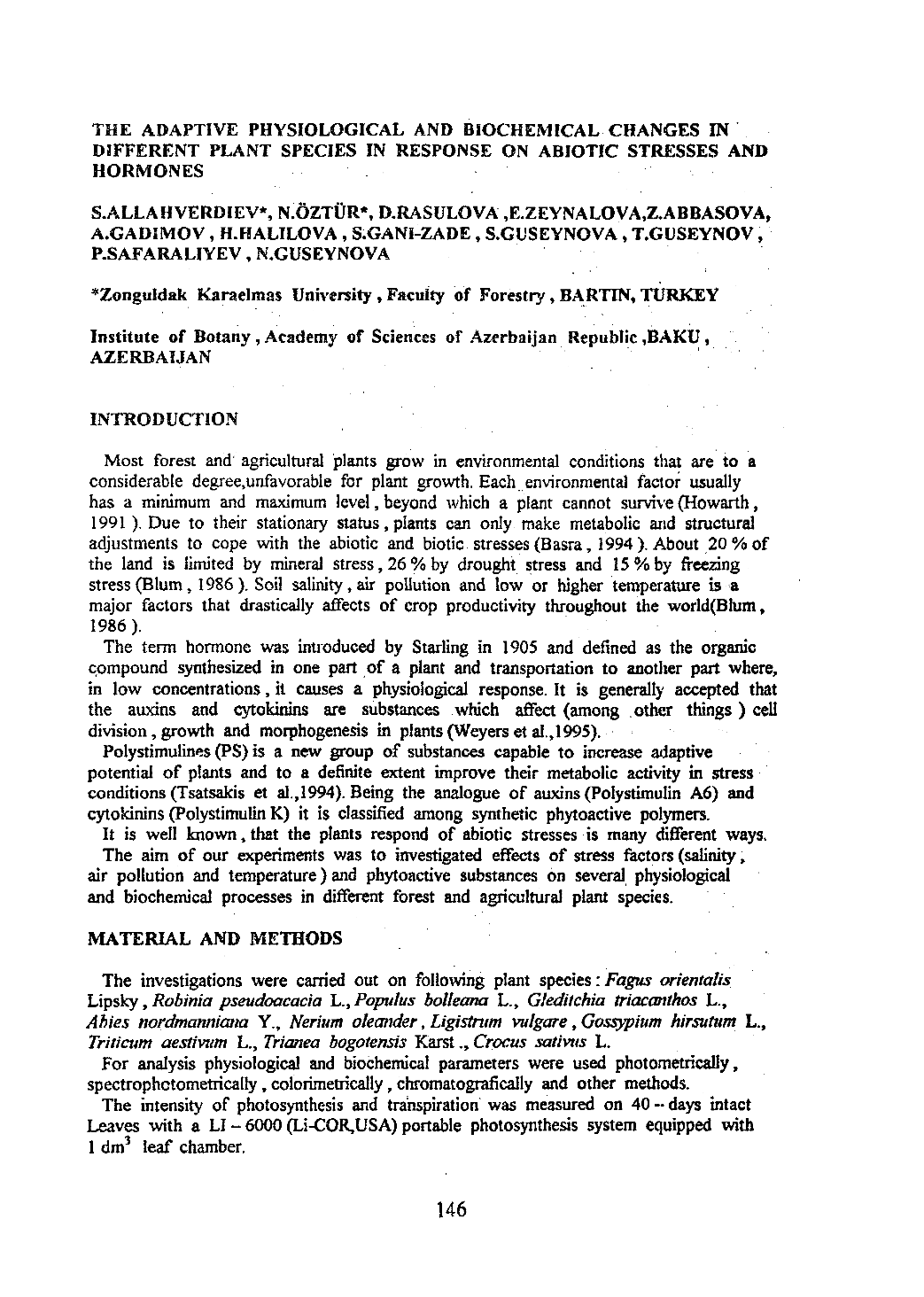
THE ADAPTIVE PHYSIOLOGICAL AND BIOCHEMICAL CHANGES IN
DIFFERENT PLANT SPECIES IN RESPONSE ON ABIOTIC STRESSES AND
HORMONES
S.ALLAHVERDIEV*, N OZTUR*, D.RASULOVA ,E.ZEYNALOVA,Z*AВBASOVA,
A.GADIMOV, H.HALILOVA , S.GANI-ZADE, S.GUSEYNOVA , T.GUSEYNOV,
P.SAFARALIYEV, N.GUSEYNOVA
*Zonguldak Karaelmas University, Faculty of Forestry, BARTIN, TURKEY
Institute of Botany, Academy of Sciences of Azerbaijan Republic ,BAKU,
AZERBAIJAN
INTRODUCTION
Most forest and agricultural plants grow in environmental conditions that are to a
considerable degree,unfavorable for plant growth. Each environmental factor usually
has a minimum and maximum level, beyond which a plant cannot survive (Howarth,
1991). Due to their stationary status, plants can only make metabolic and structural
adjustments to cope with the abiotic and biotic stresses (Basra, 1994). About 20
%
of
the land is limited by mineral stress, 26% by drought stress and 15% by freezing
stress (Blum, 1986). Soil salinity, air pollution and low or higher temperature is a
major factors that drastically affects of crop productivity throughout tie world(BIum,
1986).
The term hormone was introduced by Starling in 1905 and defined as the organic
compound synthesized in one part of a plant and transportation to another part where,
in low concentrations, it causes a physiological response. It is generally accepted that
the auxins and cytokinins are substances which affect (among other things) cell
division, growth and morphogenesis in plants (Weyers et a!.,1995).
Polystimulines (PS) is a new group of substances capable to increase adaptive
potential of plants and to a definite extent improve their metabolic activity in stress
conditions (Tsatsakis et al.,1994). Being the analogue of auxins (Polystimulin A6) and
cytokinins (Polystimulin K) it is classified among synthetic phytoactive polymers.
It is well known, that the plants respond of abiotic stresses is many different ways.
The aim of our experiments was to investigated effects of stress factors (salinity,
air pollution and temperature) and phytoactive substances on several physiological
and biochemical processes in different forest and agricultural plant species.
MATERIAL AND METHODS
The investigations were carried out on following plant species:
Fagus orientalis
Lipsky,
R obm ia pseudoacacia
L.,
Populus bolleana
L.,
Gleditchia triacanthos
L.,
A bies nordmanniatta
Y.,
Nerium oleander
,
Ligistrum vulgare
,
Gossypium hirsutum
L.,
Triticum aestivum
L.,
Trianea bogotensis
K a r st
Crocus sativus
L.
For analysis physiological and biochemical parameters were used photometrically,
spectrophctometrically, colorimetricaliy, chromatografically and other methods.
The intensity of photosynthesis and transpiration was measured on 40 - days intact
Leaves with a LI - 6000 (Li-COR,USA) portable photosynthesis system equipped with
1 dm3 leaf chamber.
146
Электронная Научная СельскоХозяйственная Библиотека








